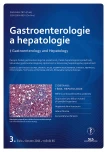Which non-steroidal anti-inflammatory drug should be used in patients with increased risk of gastrointestinal toxicity?
Commentary on CONDOR study
Authors:
M. Bortlík 1,2; M. Lukáš 1,3
Authors‘ workplace:
Klinické a výzkumné centrum pro střevní záněty, ISCARE a 1. LF UK v Praze
1; Interní klinika, 1. LF UK a ÚVN Praha
2; Ústav klinické biochemie a laboratorní diagnostiky, 1. LF UK v Praze
3
Published in:
Gastroent Hepatol 2011; 65(3): 159-160
Category:
Commentary
Sources
1. Lukáš M, Chalupná P, Adamec S et al. Adverse effects of non-steroidal antirheumatic agents on the digestive tract. Sb Lek 2002; 103(2): 265–272.
2. Ng SC, Chan FLK. NSAID-induced gastrointestinal and cardiovascular injury. Curr Opin Gastroenterol 2010; 26(6): 611–617.
3. Chan FKL, Lanas A, Scheiman J et al. Celecoxib versus omeprazole and diclofenac in patients with osteoarthritis and rheumatoid arthritis (CONDOR): a randomised trial. Lancet 2010; 376(9736): 173–179.
4. Spiegel BMR, Farid M, Dulai GS et al. Comparing rates of dyspepsia with coxibs vs NSAID+PPI: a meta-analysis. Am J Med 2006; 119(5): 448.
Labels
Paediatric gastroenterology Gastroenterology and hepatology SurgeryArticle was published in
Gastroenterology and Hepatology

2011 Issue 3
- Metamizole vs. Tramadol in Postoperative Analgesia
- Metamizole at a Glance and in Practice – Effective Non-Opioid Analgesic for All Ages
- Metamizole in perioperative treatment in children under 14 years – results of a questionnaire survey from practice
- Obstacle Called Vasospasm: Which Solution Is Most Effective in Microsurgery and How to Pharmacologically Assist It?
- Possibilities of Using Metamizole in the Treatment of Acute Primary Headaches
Most read in this issue
- Importance of portosystemic pressure gradient measurement (HVPG) in patients with liver cirrhosis
- Hepatocellular carcinoma – diagnosis and treatment from the medical oncology perspective
- Unusual complication of chronic pancreatitis
- Serum concentration of hyaluronic acid correlates with the degree of fibrosis and portal hypertension
